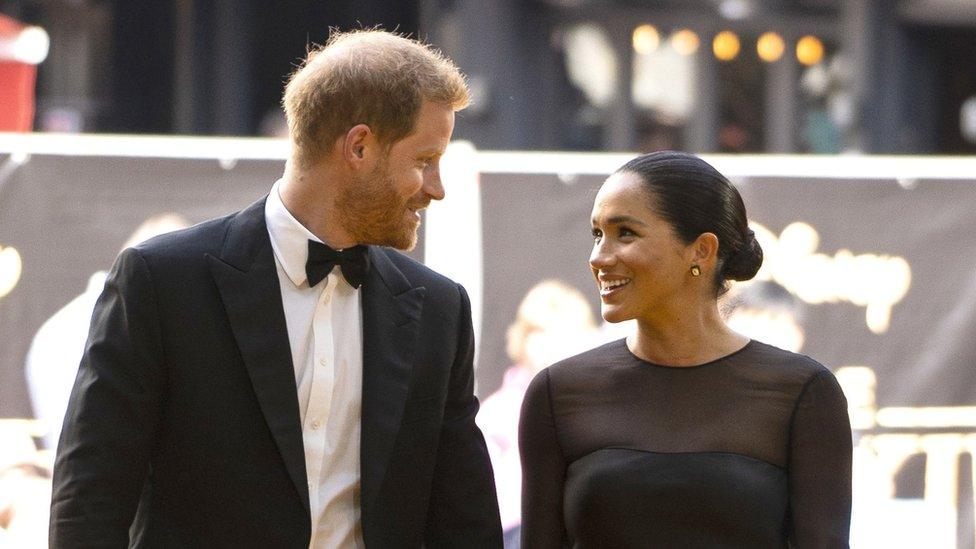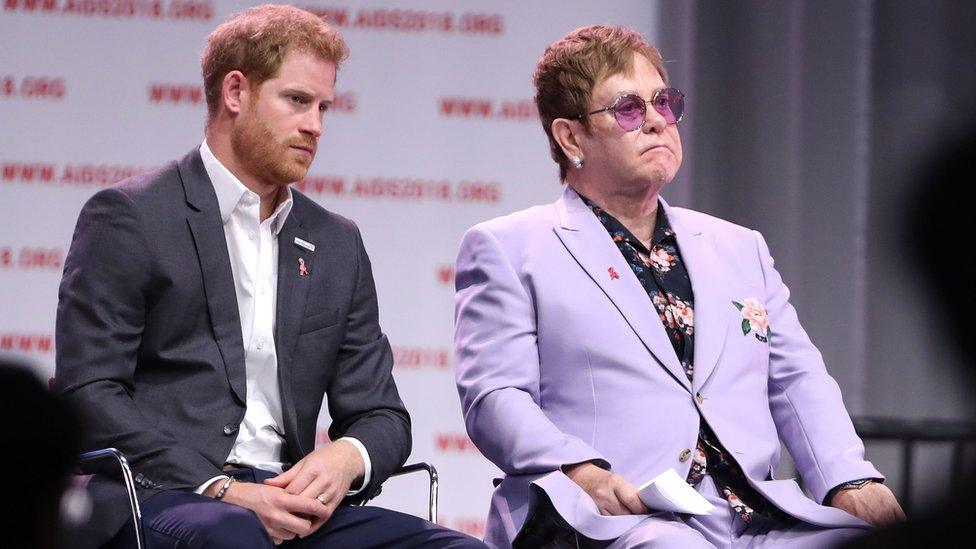Prince Harry and private jets: What's the carbon footprint?
- Published

Sir Elton John has defended the Duke and Duchess of Sussex's use of a private jet. The singer said he provided them with his private plane for a visit to his home in Nice to "maintain a high level of much-needed protection".
Questions have been asked about the royal couple's use of private jets and their environmental impact, especially after Prince Harry recently said on Instagram, external: "With nearly 7.7 billion people inhabiting this Earth, every choice, every footprint, every action makes a difference."
Allow Instagram content?
This article contains content provided by Instagram. We ask for your permission before anything is loaded, as they may be using cookies and other technologies. You may want to read Meta’s Instagram cookie policy, external and privacy policy, external before accepting. To view this content choose ‘accept and continue’.
We've been trying to work out what the carbon emissions would be for the flights. Online emissions calculators do not factor in private jets, but companies do calculate emissions privately for clients.
Prince Harry and Meghan's trip to Nice was reported to have been on a 12-seat Cessna Citation Sovereign, which has a fuel consumption of 205 gallons per hour.
The flight time to Nice is about one hour 40 minutes, which would mean a fuel requirement of 342 gallons (1,556 litres).
The Department for Business, Energy and Industrial Strategy (BEIS) says 2.52kg of carbon dioxide is emitted for every litre of aviation turbine fuel burned.
The emissions weigh more than the original fuel because, during combustion, each carbon atom joins with two oxygen atoms from the air to create the CO2.
For 1,556 litres, this means a total of 3.9 tonnes of carbon dioxide is emitted. For a return flight, it would be 7.8 tonnes.

The couple also reportedly flew to Ibiza this month, on a nine-seater Cessna - with slightly lower fuel consumption, but an estimated flight time of two hours 10 minutes. Using the same calculation method, it works out at 4.3 tonnes of CO2, and 8.6 tonnes for the return flight.
The total for the two flights would therefore be 16.4 tonnes, equivalent to more than three times the annual carbon footprint of the average Briton.
However, BEIS recommends that to "capture the maximum climate impact" of flights, CO2 emissions figures should be multiplied by 1.9 to reflect the effect of non-CO2 emissions released by planes at high altitude, which, scientists say, increase the warming effect on the climate. There is though, some scientific uncertainty about how exactly to calculate this.
Including that would give a figure of 31.2 tonnes from the two return flights - more than six times an average Briton's yearly emissions.

Carbon offsetting
Sir Elton said he paid to carbon offset their trip to his French home.
Carbon offsetting allows passengers to pay extra to help compensate for the carbon emissions produced from their flights.
The money is then invested in environmental projects - such as planting trees or installing solar panels - aimed at reducing the greenhouse gases in the air by the same amount.
On some airlines, passengers can pay the additional charge when they buy their tickets, but independent offsetting companies also exist, which estimate how much carbon dioxide has been released into the atmosphere by a particular flight and give a price for offsetting it. Different calculators give different figures for emissions from the same journey.
Some activists have criticised carbon offsetting as an excuse to continue polluting, arguing that it does little to change behaviour.
For example, when Heathrow Airport announced, external it was going to invest in restoring peat land west of Manchester to make the airport carbon neutral by 2020, Green MP Caroline Lucas described it, external as "taking economy with truth to new levels".
Clearly, offsetting the CO2 from a private jet flight is considerably more expensive than a commercial plane because you are paying for the whole plane instead of just a few of the seats in it.
To offset 31.2 tonnes of carbon with Carbon Footprint, external, the company Sir Elton says he used, would cost £234 for unspecified projects generating Certified Emissions Reductions, or £300 to plant enough trees in Kenya, or £407 to plant enough trees in the UK.
We asked Buckingham Palace for a statement about the flights but it declined to comment. The BBC understands that the Duke and Duchess of Sussex practise carbon offsetting in their private travel.
How do private jets compare?
When carbon emissions are calculated for commercial flights, the emissions for the whole plane are split between the number of people on board to give a figure per passenger. For business and first class, there's more space per seat than in economy, so each person accounts for a larger amount of the plane's pollution.
So how does the royal couple's private jet travel compare?
If their planes were full (for example with members of the royal entourage), their emissions per person would be more than four times those per person for economy return flights to Nice and Ibiza, using the calculator provided by Carbon Footprint.
Their emissions would be roughly three times the emissions per person on business class flights.
If it was only the family of three in the plane, it would be a greater multiple.
It's also worth noting that emissions for private jet travel in general may be even higher because - as Private Jet Club UK points out - private jets fly empty 40% of the time.
They might be used for a one-way flight but then have to fly elsewhere to pick up other passengers, while commercial airlines will plan their routes more efficiently.
Update 3 November 2021: The piece has been amended to change US gallons to UK gallons in the examples of the Cessna planes.



- Published19 August 2019
